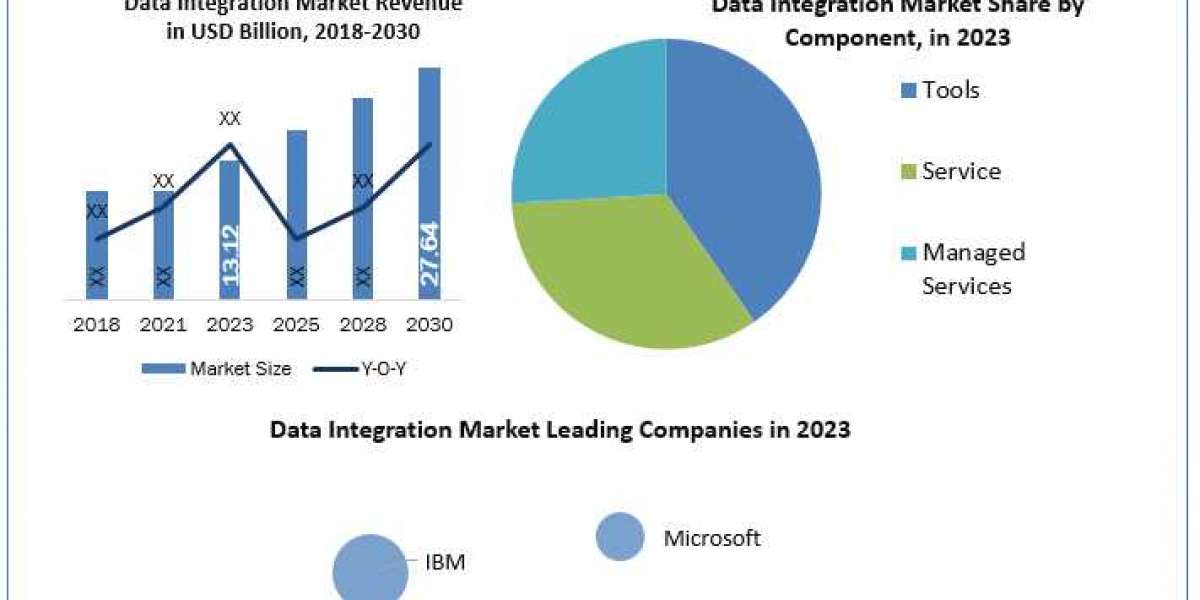Data Integration Market size was valued at US$ 13.12 Bn in 2023. The Global Data Integration Market is estimated to grow at a CAGR of 11.23% over the forecast period.
Data Integration Market Overview:
The Data Integration Market research report explores and evaluates the market's position during the predicted period. It is an in-depth study that focuses on fundamental and secondary drivers, market dominance, key segments, and geographic analysis. The research also looks at notable individuals, large collaborations, mergers, and acquisitions, as well as contemporary innovation and corporate strategy.
Data Integration Market Scope:
The data integration market encompasses a wide range of technologies, solutions, and services aimed at facilitating the seamless integration and consolidation of data from disparate sources within an organization. This market addresses the growing need for businesses to efficiently manage and analyze vast amounts of data generated from various systems, applications, databases, and external sources.
Key aspects of the data integration market scope include:
1. Technology Landscape:
- Extract, Transform, Load (ETL) Tools: Traditional data integration tools focused on extracting data from source systems, transforming it to meet target schema requirements, and loading it into a destination database or data warehouse.
- Enterprise Service Bus (ESB) and Middleware: Integration platforms that enable real-time data exchange and communication between applications, systems, and services using standardized protocols.
- Data Virtualization: Technologies that provide a unified view of data across multiple sources without physically moving or replicating data, enabling faster access and analysis.
- API-based Integration: Utilizing Application Programming Interfaces (APIs) to connect and integrate data and functionalities between different applications and services.
2. Market Segments:
- On-Premises Solutions: Traditional data integration solutions deployed within an organization's infrastructure, offering control, security, and customization options.
- Cloud-Based Solutions: Data integration platforms hosted in the cloud, providing scalability, flexibility, and accessibility for organizations adopting cloud technologies.
- Hybrid Integration: Combination of on-premises and cloud-based data integration solutions to leverage the benefits of both environments and address complex integration scenarios.
3. Industry Verticals:
- Financial Services: Utilizing data integration for risk management, regulatory compliance, customer analytics, and real-time reporting.
- Healthcare: Integrating electronic health records (EHRs), medical devices, and patient data for improved patient care, research, and healthcare analytics.
- Retail and E-commerce: Integrating customer data, inventory management systems, and sales channels for personalized marketing, supply chain optimization, and business insights.
- Manufacturing and Supply Chain: Integrating manufacturing systems, IoT devices, and supply chain data for predictive maintenance, inventory optimization, and operational efficiency.
4. Emerging Trends:
- Big Data Integration: Handling and integrating large volumes of structured and unstructured data from sources such as IoT devices, social media, and streaming analytics platforms.
- AI and Machine Learning Integration: Incorporating AI and ML capabilities into data integration processes for automated data mapping, cleansing, and predictive analytics.
- Data Governance and Security: Ensuring data quality, compliance, and security throughout the integration lifecycle, including data masking, encryption, and access control measures.
Overall, the data integration market continues to evolve with advancements in technology, changing business requirements, and the growing importance of data-driven decision-making across industries. Organizations are increasingly investing in robust data integration solutions to unlock the full potential of their data assets and drive business growth and innovation.
Request for inquiry: https://www.stellarmr.com/report/enquire_now/Data-Integration-Market/460
Data Integration Segmentation:
The data integration market can be segmented into several categories based on various criteria, reflecting the diverse applications and target customers within the business landscape.
Firstly, by deployment model, organizations can choose between on-premises data integration solutions, which offer control, security, and customization options but require dedicated hardware and IT resources, or cloud-based data integration platforms hosted in the cloud, providing scalability, flexibility, and accessibility without the need for on-site infrastructure.
Secondly, based on integration type, data integration can be classified into batch data integration, where data is processed in batches at scheduled intervals using traditional ETL (Extract, Transform, Load) processes, and real-time data integration, which enables continuous data streaming and processing for applications requiring up-to-date insights and analytics.
Thirdly, data integration segmentation can be done by use case, including data warehousing for centralized data storage and analytics, application integration for seamless communication between business applications and systems, big data integration for handling large volumes of structured and unstructured data, and business process integration (BPI) for automating and optimizing workflows across departments.
Lastly, data integration solutions can be tailored to specific industry verticals such as financial services, healthcare, retail, and manufacturing, addressing unique integration challenges and requirements within each sector. For example, financial services may focus on risk management and regulatory compliance, healthcare on integrating electronic health records (EHRs) and medical devices, retail on customer data integration and supply chain optimization, and manufacturing on integrating IoT devices and ERP systems for operational efficiency.
Each segment within the data integration market offers distinct functionalities, benefits, and challenges, catering to the diverse needs of organizations across industries and driving innovation in data management and analytics.
By Component
Tools
Service
Managed Services
Professional Services
By Deployment Mode
On-Premises
Cloud
Key Players:
IBM (US)
Microsoft (US)
SAP (Germany)
Oracle (US)
SAS Institute (US)
Talend (US)
Informatica (US)
Precisely (US)
Software AG (Germany)
Salesforce (US)
Qlik (US)
Tibco (US)
Syncsort (Bulington, MA)
Panoply Ltd (US)
Intel Corporation (Santa Clara, CA)
Primary and secondary research is used to determine market leaders, while primary and secondary research are used to compute market revenue. The core study included in-depth interviews with key thought leaders and industry specialists such as experienced front-line personnel, CEOs, and marketing professionals. In-depth interviews with important thought leaders and industry specialists, such as experienced front-line personnel, CEOs, and marketing professionals, were conducted as part of primary research, while secondary research included a study of the major manufacturers' annual and financial reports. Secondary sources are utilized to compute percentage splits, market shares, growth rates, and global market breakdowns, which are then compared to historical data. The players highlighted in this report are as follows:
Request for inquiry: https://www.stellarmr.com/report/enquire_now/Data-Integration-Market/460
Data Integration Regional Analysis:
Regional analysis in the data integration market reveals nuanced trends and dynamics shaped by factors such as technological adoption, regulatory environments, economic development, and industry landscapes.
North America stands out as a key hub for data integration solutions, driven by a mature IT infrastructure, widespread adoption of advanced technologies, and a high concentration of businesses across various sectors. The region's regulatory frameworks, particularly regarding data privacy and security, influence the adoption of data integration platforms with robust compliance features. Additionally, industries such as finance, healthcare, and retail in North America heavily rely on data integration for analytics, customer insights, and operational efficiency.
Europe follows a similar trajectory, with countries like the UK, Germany, and France leading in data integration deployments. The European market emphasizes data protection regulations under GDPR (General Data Protection Regulation), driving investments in secure and compliant data integration solutions. Industries like manufacturing, automotive, and telecommunications leverage data integration for supply chain optimization, IoT data management, and customer experience enhancement.
Asia-Pacific showcases rapid growth and adoption of data integration technologies, fueled by expanding digitalization efforts, emerging economies, and a thriving tech ecosystem. Countries such as China, India, and Japan are witnessing increased demand for data integration solutions across sectors like healthcare, e-commerce, logistics, and finance. Government initiatives promoting digital transformation and data-driven decision-making further boost the regional data integration market.
Latin America and the Middle East Africa (MEA) regions are also experiencing growing interest in data integration solutions, albeit at a slightly slower pace compared to other regions. Factors such as improving internet infrastructure, rising investments in IT modernization, and a burgeoning startup culture contribute to the adoption of data integration platforms in these regions. Industries such as energy, retail, and government sectors in MEA are increasingly leveraging data integration for analytics, regulatory compliance, and operational efficiency improvements.
Overall, the regional analysis of the data integration market underscores diverse opportunities and challenges across different geographies, reflecting the global evolution toward data-driven decision-making and digital transformation across industries.
COVID-19 Impact Analysis on Data Integration Market:
We thoroughly researched and analyzed the Global Data Integration Market Development Strategy post-COVID-19, by corporate strategy analysis, landscape, type, application, and leading countries, which encompasses and analyses the global Data Integration Market industry's potential, providing statistical data on market dynamics, growth factors, major challenges, PORTER analysis, and market entry strategy analysis, opportunities, and forecasts. The primary goal of the research is to provide enterprises in the industry with a strategic analysis of the impact of COVID-19. Simultaneously, this research investigated the marketplaces of significant nations and presented their market potential.
Key Questions Answered in the Data Integration Market Report are:
- What are the most potential high-growth prospects in the worldwide Data Integration Market industry, broken down by product category, End User, and Region?
- Which Data Integration Market categories will grow the most rapidly, and why?
- Which regions will grow faster, and why?
- What are the major factors impacting Data Integration Market dynamics? What are the Data Integration Market's major drivers and challenges?
- What are the business risks and dangers in the Data Integration Market?
Contact:
Stellar Market Research PVT. LTD.
3rd Floor, Navale IT Park Phase 2,
Pune Banglore Highway,
Narhe, Pune, Maharashtra 411041, India.







